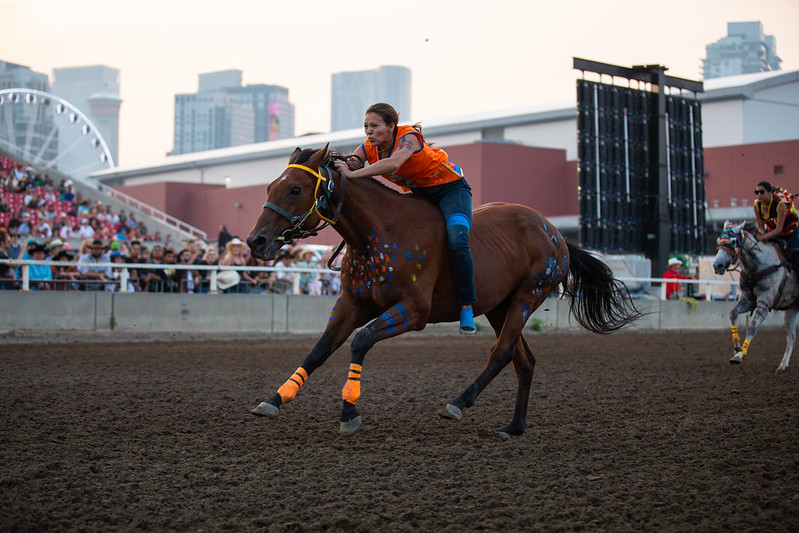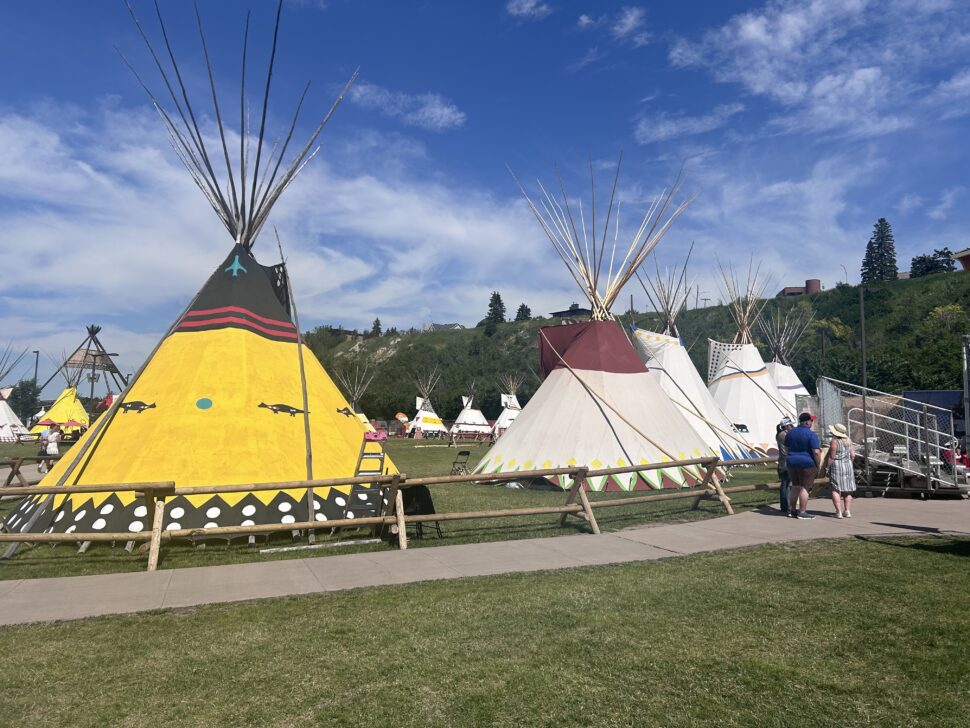Most travelers wouldn’t expect to experience the best rodeo show of their lives in Canada. Rodeos and cowboy culture are typically associated with the American West. For years, Americans have told stories about the Wild West, with its gun-toting cowboys, gold rushes, and majestic stallions. It has become cultural lore. However, Calgary, Alberta, has a few rodeo tricks up its sleeve that go beyond the saddle.
Every summer, the Calgary Stampede takes over the Canadian city. This 10-day rodeo experience honors Calgary’s traditions, culture, and heritage. It’s much more than just a rodeo, with 1,331,280 guests from around the world attending the 2024 Stampede. The entertainment at the Calgary Stampede was endless. From intense rodeo competitions like barrel racing and bronc riding to carnival rides and live performances, the Stampede kept guests excited while advocating for community and unity among all Calgarians.
Amid a million attendees, bright fireworks, and thrilling rodeo adventures, I changed after my experience at the Calgary Stampede. It only took a few days to understand why Calgary was voted the world’s friendliest city in 2023.
Honoring Indigenous Culture

Upon arriving in Calgary, my expectations of the Stampede were limited to my basic knowledge of rodeo festivities in the United States. Of course, cowboy hats, custom boots, animals, and local pride would be on full display. However, I quickly realized the Calgary Stampede was a symbol of unity and community for the city and everyone who has ever lived there.
When the Calgary Stampede first started in 1912, it marked one of the first times the Indigenous people of the region were able to enjoy a small dose of freedom. Like the United States, the Indigenous tribes of Canada resided in the province long before the arrival of European settlers. These people, originally known as the Plains First Nations, united in agreement with the Canadian government under Treaty 7 in 1877. It included five tribes, and for years, they were required to remain on the reserves or face arrest. However, the Treaty 7 tribes were granted permission to leave to attend the first Stampede 112 years ago, according to ICT News.
Today, the Treaty 7 tribes and Indigenous culture are the heart and soul of the Stampede. Bold representations of Calgary’s Indigenous community were everywhere I looked. Before heading to the rodeo grounds, I visited the Sam Centre, an interactive, immersive exhibit full of a century’s worth of Stampede stories.

A new addition to the city, the Sam Centre opened my eyes to the importance of the Stampede to the tribes and the city. Members of the Treaty 7 tribes described how they anticipate the rodeo every year. They prepare their skins for teepees and fabric for traditional dress months in advance. Each tribe is unique, and the Stampede celebrates their differences while honoring the spirit of their people and traditions.
During the rodeo, the Treaty 7 tribes shined during the Indigenous Relay. I’d never witnessed anything like it, as young men with their bodies painted raced bareback around the track. Before every lap, riders jumped onto a new horse, also painted in tribal patterns. A sheer display of strength and bravery, the Indigenous relay was my favorite event during the rodeo competitions.
Outside the Saddledome, I walked through the majestic teepees at Elbow River Camp. An annual Stampede tradition, Treaty 7 tribes erect 26 towering handmade teepees along the Elbow River, representing the five Indigenous nations of southern Alberta. Some of the families who built the teepees reside there throughout the rodeo and host events educating guests on the Treaty 7 nations. There was even a pow-wow where tribal members competed and showcased the beauty of their music and dance.
Calgary At Its Best

Although travelers can visit Calgary any time of year, the city is at its best during the Stampede. The love radiates from everyone you encounter. There are pancake breakfasts happening all over town, an ode to the city’s love for the sweet, morning delicacy. Cowboys and competitors gathered at the Saddledome from every corner of the continent. Concerts and DJ sets ruled the night. Everywhere I turned, there was a smiling face, and I found myself beaming with excitement in a sea of white cowboy hats symbolizing their unity.
There were endless exhibits, attractions, and rides within Stampede Park. With over a dozen rides, a slew of food booths, and live entertainment, guests could spend multiple days having new experiences at the Stampede. The stadium was full of art displays and vendors selling western wear, rodeo gear, and memorabilia. An Indigenous marketplace lined the sidewalk leading to the teepees at Elbow River Camp. From morning until night, the Calgary Stampede was a nonstop stream of Canadian hospitality and immense local pride.
In addition to the Indigenous relay, there were six other competitions during the rodeo. Thousands of guests cheered as cowboys and cowgirls competed in barrel racing, bull riding, bareback, steer wrestling, and tie-down roping. Competitors traveled from around the continent to compete in the Stampede and to stamp their names in Calgarian history.

The Stampede is also a great time to experience Calgary’s gastronomic culture. Over a dozen food vendors lined the Midway in Stampede Park. I tried a bit of everything from a messy watermelon burger and pickle fries to savory lobster bao and poutine. The diversity of food options showcased chefs and restaurants from all over Canada and left me wishing I had more time to explore every menu.
During my last night at the rodeo, I had dinner at a fine dining restaurant in the Saddledome, overlooking the rodeo arena. The four-course meal was excellent as I watched the relay and cheered from my seat.
Towards the end of the competition, the arena transformed into a giant stage with musical performances, dancers, flame throwers, aerial acrobats, and caged motorcyclists. As a finale, a drone and fireworks show illuminated the night sky, solidifying Calgary as the best international destination I’ve ever visited.
The Freedom Of Travel

I’ve visited many destinations over the past few years. As a Black American journalist, I always have looming thoughts when traveling internationally. I’ve written stories about the perceived entitlement of U.S. citizens when traveling abroad. Online forums and platforms are full of posts about international dislike for American tourists, intentional price gouging, and a general disdain for American privilege. Some of these things I have experienced in international destinations as a Black traveler.

However, Calgary wasn’t like that. Instead, everyone I met welcomed me like someone they’d met before. They embraced me, placed a white hat on my head, and deemed me an honorary Calgarian. The guests and event volunteers I spoke with lit up when discussing their love for their city, its history, and the Stampede. Their enthusiasm was infectious, and I was illuminated by the city’s graceful charm and kindness.
Calgary showed me the real freedom of travel. It opened my eyes to a form of cultural inclusion that seems foreign in the U.S. Despite their differences, I watched Calgarians from all backgrounds come together to celebrate their heritage, both shared and separate. It was a beautiful experience that felt endearing and familiar, almost like home.





